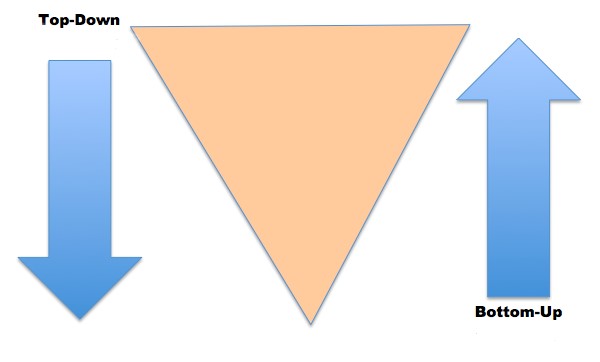Top down and bottom up estimating
Contents |
[edit] Introduction
An estimate is an attempt to predict the likely expenditure associated with a project as accurately as possible. The degree of detail and the accuracy of estimates will typically increase as the project progresses, more decisions have been made, and more information is available, however, their true accuracy only becomes apparent once the project is complete and the actual costs have been incurred.
At the outset, estimates may help determine whether a project is affordable and to set a budget. They will then be used to test design options to ensure they are in line with the budget.
There are a number of methods available for estimating, depending on the stage of the project and the information available:
- Benchmarking, which is a process by which other similar projects are used as comparisons.
- Breaking down an overall estimated construction cost into percentages for different elements, based on the experience of the cost consultant.
- Measuring defined quantities from drawings and specifications.
[edit] Top down and bottom up
There are two approaches that can be used to create an estimate. These are known as top down estimating or bottom up estimating. These terms are also used in other areas of business, finance, investing and economics.
Simply put, top down looks at general project scope and works its way down to specifics. Bottom up works in the opposite manner. It starts with specific project details and moves up to general project scope. Both techniques rely on data and can be used during different stages of the project. Top down is generally used first, followed by bottom up.
[edit] Top down
This estimating approach starts with the overall project and highlights the significant components of the work as percentages of the overall cost. Top down estimates are often based on past projects with similar characteristics. Estimates created at the top down approach tend to be broad. They are most often used during the early stages of a project with the recognition that concrete details and accurate data will be limited.
[edit] Benefits of top down estimates
Top down estimates can be produced relatively quickly and cheaply when compared to bottom up estimates. They are often large or rough estimates based on tentative scenarios. As such, there is less likelihood for error due to omission, since the estimates are not based on granular details. By looking at the bigger picture, top down estimates can help support decisions that will dictate the viability of a project.
[edit] Disadvantages of top down estimates
While the abstract nature of top down estimates has its benefits, this also means there can be an issue with accuracy, since details are lacking. This can result in estimates with loosely defined tasks, and can make it difficult to compare alternatives
Top down estimates are not suitable in situations where well defined budgets and schedules are required.
[edit] Bottom up
The bottom up approach looks at the project from the most specific practical level producing estimates for individual tasks or elements that have been defined at that stage of the project. These estimates are then compiled to create a total budget.
Solid data for task descriptions, task dependencies and resource requirements are the basis for bottom up estimating. This information may only be available at later stages of the project.
[edit] Benefits of bottom up estimates
Bottom up estimates are generally more accurate than their top down counterparts. It may also be easier to gather information, since the data will come from concrete sources and activities.
Since bottom up estimates are based on a series of elements, it may be easier to correct errors and increase accuracy.
[edit] Disadvantages of bottom up estimates
Bottom up estimates can be more expensive and time consuming to create. They can also lack integration, since components are sometimes treated as separate.
[edit] Related articles on Designing Buildings Wiki
Featured articles and news
Building Safety Regulator reforms
New roles, new staff and a new fast track service pave the way for a single construction regulator.
Cooling centres and cool spaces
Managing extreme heat in cities by directing the public to places for heat stress relief and water sources.
Winter gardens: A brief history and warm variations
Extending the season with glass in different forms and terms.
Restoring Great Yarmouth's Winter Gardens
Transforming one of the least sustainable constructions imaginable.
Construction Skills Mission Board launch sector drive
Newly formed government and industry collaboration set strategy for recruiting an additional 100,000 construction workers a year.
New Architects Code comes into effect in September 2025
ARB Architects Code of Conduct and Practice available with ongoing consultation regarding guidance.
Welsh Skills Body (Medr) launches ambitious plan
The new skills body brings together funding and regulation of tertiary education and research for the devolved nation.
Paul Gandy FCIOB announced as next CIOB President
Former Tilbury Douglas CEO takes helm.
UK Infrastructure: A 10 Year Strategy. In brief with reactions
With the National Infrastructure and Service Transformation Authority (NISTA).
Ebenezer Howard: inventor of the garden city. Book review.
The Grenfell Tower fire, eight years on
A time to pause and reflect as Dubai tower block fire reported just before anniversary.
Airtightness Topic Guide BSRIA TG 27/2025
Explaining the basics of airtightness, what it is, why it's important, when it's required and how it's carried out.
Construction contract awards hit lowest point of 2025
Plummeting for second consecutive month, intensifying concerns for housing and infrastructure goals.
Understanding Mental Health in the Built Environment 2025
Examining the state of mental health in construction, shedding light on levels of stress, anxiety and depression.
The benefits of engaging with insulation manufacturers
When considering ground floor constructions.
Lighting Industry endorses Blueprint for Electrification
The Lighting Industry Association fully supports the ECA Blueprint as a timely, urgent call to action.






















